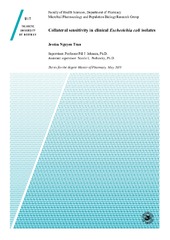Collateral sensitivity in clinical Escherichia coli isolates
Permanent lenke
https://hdl.handle.net/10037/29208Dato
2018-05-15Type
Master thesisMastergradsoppgave
Forfatter
Tran, Jessica NguyenSammendrag
Background At present time, antimicrobial resistance is emerging more rapidly than the development of novel antimicrobials, presenting a serious threat to how we prevent and treat infectious diseases. Several treatment strategies to counteract this development have been proposed, among these is the use of collateral sensitivity in clinical treatment. The ability to predict collateral sensitivity and cross-resistance effects is essential to exploiting this concept. In this study, we aimed to investigate the patterns of collateral sensitivity and cross-resistance in ciprofloxacin resistant isolates carrying gyrA and parC mutations.
Method Ciprofloxacin resistant isolates were evolved from three clinical E. coli strain using static and dynamic selection methods. Isolates were selected based on identified mutations and level of ciprofloxacin resistance measured with diffusion gradient strips. DNA sequencing was used to detect mutations in gyrA and parC. Resistant isolates carrying at least one gyrA and parC mutation were characterized by IC90 assays with micro-broth dilutions of six unrelated antimicrobial agents. The observed collateral sensitivity and cross-resistance effects were displayed in a heat map.
Results Various non-synonymous point mutations in gyrA and parC were identified in several of the generated ciprofloxacin resistant isolates. These mutants displayed collateral sensitivity and cross-resistance to several unrelated antimicrobials. Collateral sensitivity to gentamicin and trimethoprim was observed in the majority isolates. Cross-resistance effects were found in several mutants, specifically to ceftazidime, chloramphenicol and colistin.
Conclusion Our findings suggest that ciprofloxacin resistant mutants with gyrA and parC mutations display a clear tendency of collateral sensitivity to gentamicin, an effect which potentially can be exploited in future treatment. However, we propose further investigation into specific point mutations within these genes, to better understand the observed variations in collateral sensitivity and cross-resistance.
Forlag
UiT Norges arktiske universitetUiT The Arctic University of Norway
Metadata
Vis full innførselSamlinger
Følgende lisensfil er knyttet til denne innførselen:


 English
English norsk
norsk
